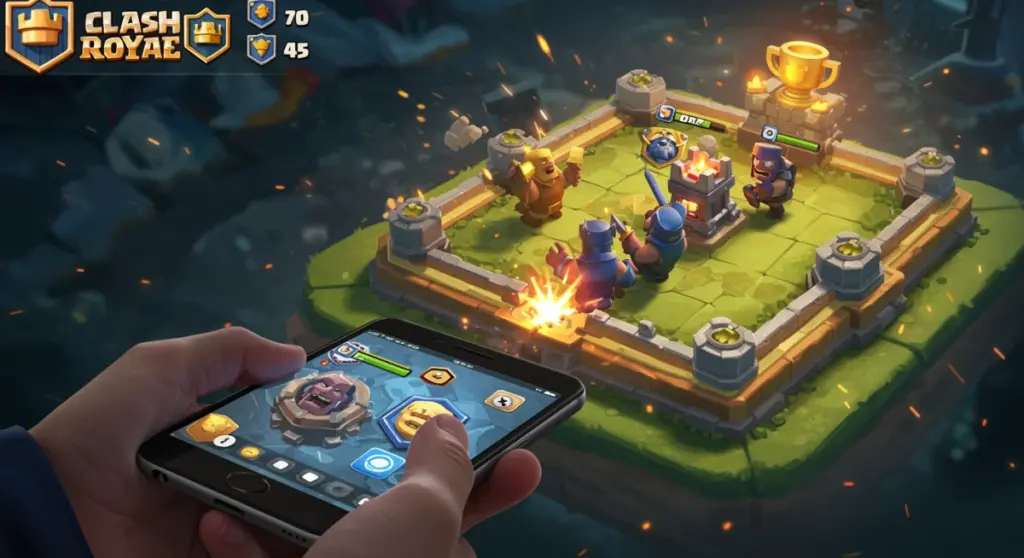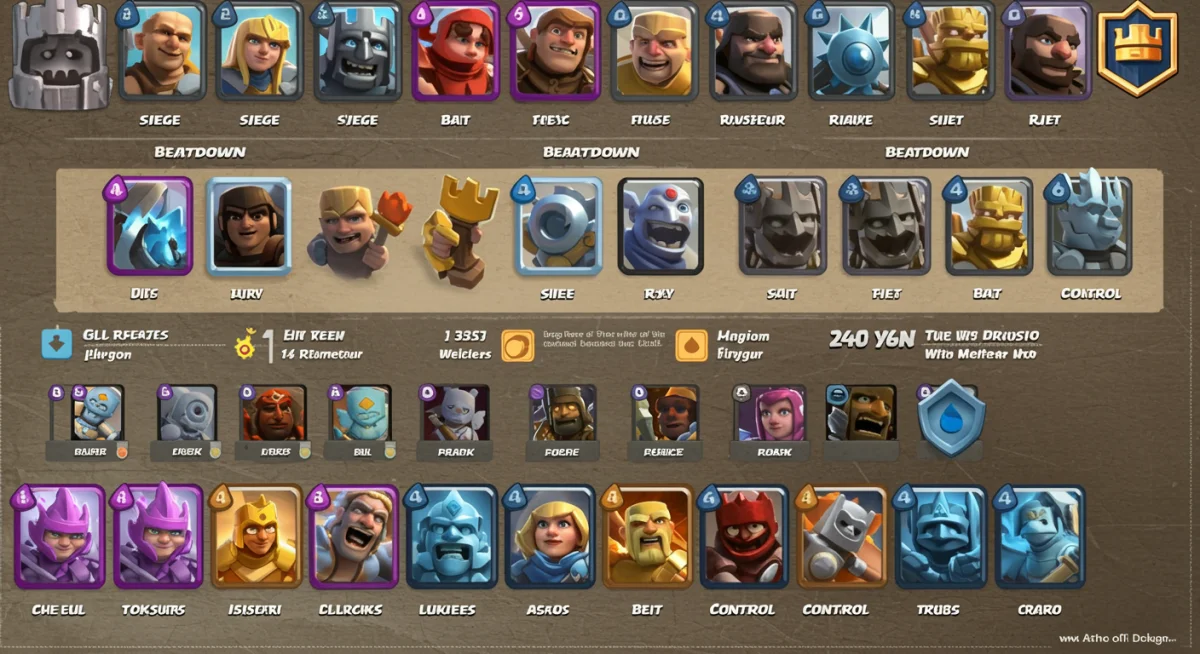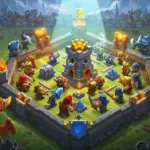Clash Royale Ladder Anxiety: Climb 500 Trophies

Anúncios
Overcoming Clash Royale ladder anxiety involves a blend of strategic deck adjustments, mental fortitude, and consistent data analysis to achieve significant trophy gains each season.
Many players experience Clash Royale Ladder Anxiety, a common psychological barrier that prevents them from pushing trophies and reaching their full potential. This feeling often stems from the fear of losing progress, the pressure of competitive play, or simply not knowing how to consistently improve. However, by adopting a structured, data-driven approach to deck adjustments and gameplay, you can not only conquer this anxiety but also climb an impressive 500 trophies this season, transforming your ladder experience into a rewarding journey of strategic mastery.
understanding ladder anxiety and its impact
Ladder anxiety in Clash Royale is more than just a fleeting nervousness; it’s a genuine psychological phenomenon that affects countless players. It manifests as hesitation to queue for matches, overthinking every play, or even completely avoiding the ladder despite a desire to climb. This anxiety can severely hinder your progress, turning what should be an enjoyable challenge into a source of stress.
Recognizing the symptoms is the first step toward overcoming it. Do you find yourself second-guessing your deck choice, fearing a losing streak, or feeling disappointed after every defeat? These are classic signs. The pressure to perform, especially when trophies are at stake, can be immense. Understanding that this feeling is normal and experienced by many top players can help normalize your own experience.
the psychological toll of competitive gaming
Competitive gaming, by its very nature, introduces a significant psychological component. The constant pursuit of victory, coupled with the immediate feedback of wins and losses, can create a high-pressure environment. This pressure can lead to:
- Decision Paralysis: Overthinking each move, leading to slower reactions and missed opportunities.
- Burnout: Exhaustion from continuous high-stress gameplay, diminishing enjoyment.
- Self-Doubt: Questioning your skill and strategic choices after losses, impacting confidence.
These elements combine to create a cycle where anxiety feeds into poor performance, which in turn exacerbates anxiety. Breaking this cycle requires a deliberate shift in mindset and approach. It’s about reframing losses as learning opportunities and focusing on consistent improvement rather than solely on immediate outcomes.
Ultimately, addressing ladder anxiety involves acknowledging its presence and developing strategies to mitigate its effects. By understanding the root causes and recognizing the psychological impact, players can begin to develop a healthier relationship with competitive play, paving the way for more consistent and enjoyable trophy pushing.
data-driven deck adjustments: the foundation of success
To effectively climb the Clash Royale ladder, relying on intuition alone is often insufficient. A data-driven approach to deck adjustments provides a solid, objective foundation for improvement. This means analyzing card win rates, usage rates, and synergy statistics to build and refine decks that are optimized for the current meta.
The Clash Royale meta is constantly evolving, with balance changes, new card releases, and community innovations shifting the strongest strategies. Staying ahead of this curve requires diligent research and a willingness to adapt. Websites like RoyaleAPI and DeckShop.Pro are invaluable resources, offering comprehensive data on card performance, popular decks, and counter-strategies.
analyzing key metrics for optimal deck building
When diving into data, several key metrics should guide your deck adjustments:
- Win Rate: How often a card or deck archetype wins. Prioritize cards and decks with consistently high win rates.
- Usage Rate: How frequently a card or deck is played. High usage rates often indicate meta relevance, but also mean you’ll encounter counters more often.
- Synergy: How well cards interact within a deck. A deck’s overall strength is often greater than the sum of its individual cards.
Consider your current trophy range and the common decks you encounter. Is there a specific archetype dominating? How can your deck be adjusted to better counter it? Sometimes, a single card swap can significantly improve your win rate against prevalent strategies. For instance, if you’re facing a lot of beatdown decks, adding a strong defensive building or a high DPS unit might be beneficial.
Regularly reviewing your own battle log is also crucial. Identify patterns in your losses: are you consistently losing to a specific card or deck type? This self-analysis, combined with external data, allows for highly targeted and effective deck adjustments. Don’t be afraid to experiment, but always base your changes on objective data rather than gut feelings.
Leveraging data for deck adjustments transforms the subjective art of deck building into a more scientific process. This approach not only leads to stronger decks but also instills confidence, directly combating the uncertainty that fuels ladder anxiety. By understanding why certain cards and decks perform well, you gain a clearer path to victory.

mastering the current meta: adapting your playstyle
Understanding the meta isn’t just about knowing which decks are popular; it’s about comprehending *why* they’re popular and how to play them effectively, or how to counter them. The meta dictates the prevailing strategies, optimal card interactions, and common elixir trades. Adapting your playstyle to the current meta is as crucial as adjusting your deck.
This adaptation involves more than just swapping cards. It means understanding the typical win conditions of top-tier decks, their defensive capabilities, and their vulnerable timings. For example, if the meta favors fast cycle decks, you need to learn to manage elixir more carefully and punish over-commitments. If beatdown is prevalent, mastering defensive placements and counter-push timing becomes paramount.
identifying common archetypes and their weaknesses
The Clash Royale landscape typically features a few dominant archetypes. Recognizing these and their inherent weaknesses is a powerful tool:
- Beatdown: Focuses on building a large push. Counter with strong defensive units, high DPS, and structures to kite.
- Siege: Relies on long-range attackers like X-Bow or Mortar. Counter by placing tanks or swarm units to distract, or using spells to clear their support.
- Bait: Forces out specific spells (e.g., Log, Zap) with cheap swarm units. Counter by holding your key spells or having multiple bait cards of your own.
- Control: Aims to gain elixir advantages and chip away at towers. Counter by forcing them to overcommit or executing strong pushes that they cannot easily defend.
Watch top players on platforms like YouTube or Twitch. Observe their decision-making, card placements, and elixir management against various meta decks. Pay attention to how they handle different win conditions and how they adapt their strategy mid-match. Emulating successful playstyles, and understanding the rationale behind them, will significantly enhance your own game.
Furthermore, practice is key. Take your adjusted decks into friendly battles or classic challenges to test them against diverse opponents without the pressure of trophy loss. This allows you to refine your execution, learn optimal card placements, and internalize the timings required for effective counter-play. Mastering the meta isn’t a one-time achievement; it’s an ongoing process of learning, adapting, and refining your skills to stay competitive.
strategic gameplay: optimizing every match
Beyond deck composition and meta understanding, strategic gameplay is the bedrock of consistent trophy climbing. Every match in Clash Royale presents a unique tactical puzzle, and success hinges on your ability to make optimal decisions under pressure. This includes effective elixir management, precise card placement, and understanding your opponent’s intentions.
One of the most critical aspects is elixir management. Every card played has an elixir cost, and maintaining an elixir advantage is often the key to victory. This means knowing when to defend minimally, when to apply pressure, and when to save elixir for a decisive push. Over-committing or wasting elixir can quickly turn the tide of a battle against you.
key elements of advanced gameplay
- Elixir Management: Track your opponent’s elixir. If they play a high-cost card, you have a window to apply pressure on the opposite lane.
- Card Cycling: Understand your deck’s cycle and your opponent’s. Know which cards are coming next and plan your plays accordingly.
- Defensive Placements: Place cards strategically to maximize their defensive utility, kite troops, or protect your tower while minimizing damage.
- Offensive Timings: Initiate pushes when you have an elixir advantage or when your opponent has just played a key counter in the other lane.
Another often overlooked aspect is understanding your opponent’s rotation. Pay attention to the cards they play and try to predict what they have in hand or what they are cycling to. If they just used their Hog Rider, you know it won’t be back for a few cycles, allowing you to be more aggressive defensively or push the other lane.
The ability to adapt mid-match is also paramount. If your initial strategy isn’t working, or if your opponent reveals an unexpected card, you must be able to pivot. This might mean shifting from an aggressive push to a more defensive stance, or vice-versa. This flexibility comes with experience and a deep understanding of card interactions and win conditions. By consistently focusing on these strategic elements, you elevate your gameplay from reactive to proactive, gaining a significant edge in every match.
the mental game: overcoming anxiety and maintaining focus
While deck adjustments and strategic gameplay are vital, the mental aspect of Clash Royale is often the most challenging to master. Clash Royale Ladder Anxiety can be a formidable opponent, leading to tilt, frustration, and poor decision-making. Overcoming this requires developing a resilient mindset and employing techniques to maintain focus and composure.
One of the most effective strategies is to change your perspective on losses. Instead of viewing them as failures, see them as valuable learning opportunities. Every defeat provides data: what went wrong? Was it a misplay, a bad matchup, or a flaw in your deck? Analyzing losses objectively, without emotional attachment, allows for continuous improvement.
strategies for mental resilience
- Set Realistic Goals: Instead of focusing on a single trophy number, aim for consistent improvement, like winning 3 out of 5 games.
- Take Breaks: If you’re on a losing streak or feeling frustrated, step away from the game. A short break can reset your mental state.
- Focus on Process, Not Outcome: Concentrate on making good plays and strategic decisions, rather than solely on winning. The wins will follow.
- Positive Self-Talk: Replace negative thoughts with constructive ones. Remind yourself of your strengths and past successes.
Another crucial element is managing tilt. Tilt occurs when frustration or anger negatively impacts your gameplay, leading to impulsive decisions and further losses. Recognizing the signs of tilt (e.g., aggressive card placements, ignoring elixir counts) is the first step. Once identified, take a break, even if it’s just for five minutes. Engage in a different activity to clear your head before returning to the ladder.
Developing a pre-game routine can also help. This might involve a quick review of your deck, a moment of deep breathing, or setting a specific goal for the upcoming match. By consistently applying these mental strategies, you can reduce the impact of ladder anxiety, maintain a calm and focused demeanor, and make clearer, more effective decisions throughout your climbing journey.
fine-tuning your deck with specific card interactions
After establishing a meta-relevant deck and refining your gameplay, the next step in conquering the ladder is to fine-tune your deck based on specific card interactions. This involves a deeper understanding of how individual cards in your deck perform against individual cards in common opponent decks. It’s about optimizing every single card slot to maximize its utility and synergy.
This level of detail moves beyond general archetype counters and delves into the micro-interactions that often decide close matches. For example, knowing if your Mini P.E.K.K.A can one-shot a specific support troop, or if your Fireball can clear a critical swarm, can inform crucial defensive and offensive plays. These small advantages accumulate over the course of a game.
optimizing card roles and synergies
- Win Condition: Is it adequately protected? Does it have enough support to break through defenses?
- Tank Killer: Can it effectively deal with high-health units like Golem or Electro Giant?
- Air Defense: Do you have enough answers for aerial threats like Balloon or Lava Hound?
- Spell Bait: Are your bait cards effective enough to draw out key spells, allowing your win condition to thrive?
Another aspect is understanding elixir trades. Every card interaction results in an elixir trade, either positive, negative, or neutral. Constantly strive for positive elixir trades, where your cards deal more damage or defend more efficiently than the elixir you spent. This often means carefully timing your spells, using splash damage effectively, or kiting troops to your tower’s advantage.
For instance, if your opponent consistently plays a high-cost troop like Pekka, having a cheap, high-damage counter like Goblin Cage or Inferno Tower can consistently generate positive elixir trades. These small, repeated advantages are what allow you to build overwhelming pushes or defend against strong attacks. This meticulous fine-tuning, based on granular card interaction data and observed gameplay, turns a good deck into a great one, significantly boosting your trophy potential.

reviewing and adapting: continuous improvement cycle
The journey to climbing 500 trophies this season is not a linear path but a continuous cycle of review and adaptation. Once you’ve implemented data-driven deck adjustments, refined your gameplay, and honed your mental fortitude, the next crucial step is to consistently review your performance and adapt your strategies. This iterative process ensures long-term growth and sustained success on the ladder.
After each play session, take time to analyze your battle log. Don’t just look at wins and losses; delve deeper. Which decks did you face? How did you perform against specific archetypes? Were there any recurring mistakes in your gameplay or card placements? Tools that track your win rates against different opponents or identify common errors can be incredibly beneficial here.
implementing a feedback loop for growth
- Battle Log Analysis: Review every match, especially losses, to identify specific misplays or execution errors.
- Replay Watching: Watch your own replays (and top player replays) to gain a new perspective on decision-making and timing.
- Community Feedback: Share your replays or deck lists with experienced players or within a clan for constructive criticism.
- Meta Monitoring: Stay updated on balance changes and new cards that could shift the meta, necessitating further deck adjustments.
This feedback loop is essential. It allows you to identify areas for improvement, whether it’s a specific card interaction you’re struggling with, a common defensive error, or an outdated deck choice. Based on this analysis, make small, targeted adjustments to your deck or gameplay. Avoid making drastic changes all at once, as it becomes harder to pinpoint the impact of any single modification.
Remember that the Clash Royale meta is dynamic. What works today might be less effective next week due to balance changes or evolving player strategies. A commitment to continuous learning and adaptation is what separates consistent climbers from those who get stuck. By embracing this cycle of review and adaptation, you not only climb trophies but also develop a deeper mastery of the game, ultimately conquering Clash Royale Ladder Anxiety for good.
| Key Strategy | Brief Description |
|---|---|
| Data-Driven Decks | Analyze card win rates and usage to build meta-optimized decks. |
| Meta Adaptation | Understand and counter prevalent deck archetypes and playstyles. |
| Mental Resilience | Overcome anxiety and tilt with strategic mindset shifts and breaks. |
| Continuous Review | Analyze battle logs and replays for ongoing improvement and adaptation. |
frequently asked questions about climbing the clash royale ladder
Clash Royale ladder anxiety is the fear or hesitation to play competitive matches due to concerns about losing trophies or progress. It often manifests as overthinking, stress before queuing, or avoiding the ladder entirely, hindering a player’s ability to climb effectively.
Data-driven deck adjustments involve analyzing card win rates, usage, and synergy from resources like RoyaleAPI. This objective approach helps you build and refine decks optimized for the current meta, countering popular strategies and improving your overall win probability significantly.
To adapt, identify dominant deck archetypes and their weaknesses. Watch top players to learn their decision-making and timings. Practice in friendly battles to refine your execution against various meta decks, focusing on elixir management and counter-play strategies.
Recognize the signs of tilt, such as frustration or impulsive plays. Take short breaks to reset your mental state, focusing on processes rather than just outcomes. Set realistic goals and practice positive self-talk to maintain composure and make better decisions.
Continuous review, including battle log analysis and replay watching, creates a feedback loop for growth. It helps identify recurring mistakes, adapt to meta shifts, and fine-tune your deck and gameplay. This iterative process ensures sustained improvement and helps you stay competitive.
conclusion
Conquering Clash Royale Ladder Anxiety and achieving significant trophy gains is an attainable goal for any dedicated player. It demands a holistic approach that integrates meticulous data-driven deck adjustments, a deep understanding of the evolving meta, and a robust mental game. By consistently analyzing your performance, adapting your strategies, and maintaining a resilient mindset, you can transform the daunting ladder into an exciting arena for growth. Remember that every loss is a lesson, and every win is a testament to your strategic evolution. Embrace the journey of continuous improvement, and the 500-trophy climb, along with greater enjoyment of the game, will undoubtedly follow.





